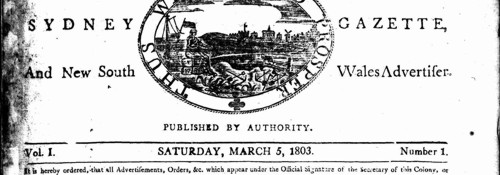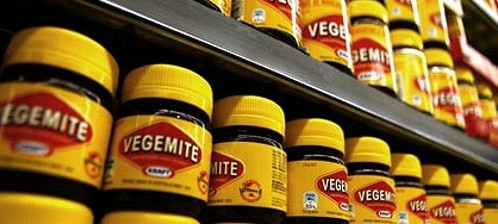Australian History – the Bits You Didn’t Know About
I think I’d be pretty right in saying that as far as Australian history that is taught in schools pretty much covers the convicts, the explorers, and the wars. And while each are fascinating in their own right, I have found other bits of Australian history that also deserve to be known. Now I can’t speak for the current generation, but I know they certainly weren’t in the syllabus when I was at school.
So get comfy, grab a coffee, and take a little look into Australia’s history, and discover the bits that you didn’t know about. And at the end, see how many of these fascinating facts you actually already knew about.
====================== The 1800s ======================
 1803 – Australia’s First Newspaper
1803 – Australia’s First Newspaper
The Sydney Gazette and New South Wales Advertiser was the first newspaper to be printed in Australia. It ran from 5 March 1803 until 20 October 1842. It was an official publication of the government of New South Wales, and was authorised by Governor King and printed by George Howe.
====================== The 1830s ======================
1838 – Pre-paid Postage
The Colonial Postmaster-General of New South Wales, James Raymond introduced the world’s first pre-paid postal system, using pre-stamped sheets as envelopes. Who knew pre-paid envelopes started way back then?
====================== The 1850s ======================
1856 – Refrigerator
Now this was a surprise too, not the fact that it was invented, but the fact it was so early. James Harrison, who was born in Dunbartonshire, Scotland in about 1816, was the son of a fisherman. James was apprenticed to a printer at Glasgow where he managed to attend the Evening College and later the Glasgow Mechanics’ Institution, where he specialised in chemistry. Harrison’s greatest achievement and much of his financial failure stemmed from his inventions: he was a pioneer in all kinds of refrigeration. At Geelong in Victoria he designed and built the plant for the first Australian manufacture of ice and began production at Rocky Point, taking out a local patent in 1854. The Bendigo brewers, Glasgow & Co., soon adopted his principles in a pioneer mechanical refrigerator. In 1856 Harrison went to London where he patented both his process and his apparatus.
1857 – Macadamia Nuts
In the 1850’s in Australia’s eastern states, these trees were noticed by a British botanist Walter Hill and by German botanist Ferdinand Von Meuller, who later became the Director of the Botanical Gardens of Brisbane, Queensland. The two men were struck with the majestic beauty of the specimens found growing in the rain forests of Queensland. The genus Macadamia was named after a prominent scientist of that time, Dr John McAdam.
1858 – Australian Rules Football
Of course this is an Aussie game, but do you know HOW it came about? Well Aussie Rules footy began its development when Tom Wills wrote a letter and published in a Victorian newspaper in calling for a “foot-ball club, a rifle club or other athletic pursuits” to keep cricketers fit during winter. An experimental match was played by Wills and others at the Richmond Paddock, later known as Yarra Park next to the Melbourne Cricket Ground on 31 July 1858. So there you go, it started as an extra sport to keep cricketers fit.
====================== The 1880s ======================
1889 – Electric Drill
I think who is reading this has either used or got someone they know to use an electric drill. They are just SO handy! On 20 August 1889 Arthur James Arnot patented the world’s first electric drill while working for the Union Electric Company in Melbourne. He designed it primarily to drill rock and to dig coal.
====================== The 1900s ======================
1901 – the Australian Flag becomes Australia’s flag
The flag’s original design (with a six-pointed Commonwealth Star) was chosen in 1901 from entries in a worldwide competition held following Federation, and was first flown in Melbourne on 3 September 1901 and this date has been proclaimed as Australian National Flag Day [we have a National Flag Day, who knew??]. Anyway a slightly different design was approved by King Edward VII in 1902. And over the next few years, the exact specifications of the flag were changed several times both intentionally and as a result of confusion, but the current ones were formally gazetted in 1934, and in 1954 the flag became recognised by the Flags Act 1953, as the “Australian National Flag”.
1902 – Notepad
Ugh, we’d all be lost without the notepad, so to Mr Birchall who decided to change history … thankyou! For 500 years, paper had been supplied in loose sheets. Launceston stationer J.A. Birchall decided that it would be a good idea to cut the sheets in half, back them with cardboard and glue them together at the top.
 1906 – Feature Film
1906 – Feature Film
The world’s first feature length film, The Story of the Kelly Gang, was a little over an hour long. And with it began a new era.
1906 – Surf Life-Saving Reel
The first surf life-saving reel in the world was demonstrated at Bondi Beach on 23 December 1906 by its designer, Bondi surfer Lester Ormsby.
====================== The 1910s ======================
1912 – Self-Propelled Rotary Hoe
At the age of 16 Cliff Howard of Gilgandra invented a machine with rotating hoe blades on an axle that simultaneously hoed the ground and puled the machine forward.
====================== The 1920s ======================
 1922 – Vegemite
1922 – Vegemite
In 1919, prior to the introduction of Vegemite, the Sanitarium Health Food Company in New Zealand began manufacturing and shipping to Australia a version of Vegemite’s biggest competitor, Marmite. Vegemite was invented in 1922 by food technologist Cyril P. Callister when there was disruption of imports of Marmite after World War I. Vegemite was registered as a trademark in Australia that same year, and the name was chosen by competition. Vegemite first appeared on the market in 1923 but faced growing competition from Marmite, from 1928 to 1935 the product was renamed as “Parwill”. Their renaming didn’t work, and the name was changed back to Vegemite.
1926 – Electronic Pacemaker
The artificial pacemaker is a wonder of modern science. This small, implantable device that regulates a human heart beat through electrical impulses has saved millions of lives. The development of this vital medical device owes much to the advances in electronics and communications brought about by modern society. In 1926, Australian doctors Mark C. Lidwell and Edgar H. Booth invented the first pacemaker. It was a portable device that consisting of two poles, one of which included a needle that would be plunged into a cardiac chamber. It was very crude, but it succeeded in reviving a stillborn baby at a Sydney hospital in 1928.
====================== The 1930s ======================
 1930 – Clapperboard
1930 – Clapperboard
You know the wooden black and white board that is used right before “Action” is called in a movie – well that’s a clapperboard, and it was used to synchronise sound and film. And the invention of this is attributed to Frank Thring Snr of Efftee Studios in Melbourne.
1934 – Ute
The car body style, known as the ‘ute’, at least in Australia and New Zealand, combines a two-door “coupe” cabin with an integral cargo bed behind the cabin—using a light-duty passenger vehicle-derived platform. It was designed by Lewis Brandt at the Ford Motor Company in Geelong, Victoria, and the first ute rolled off the Ford production lines in 1934. Now the really cool bit about this history is that the idea came from a Geelong farmer’s wife who wrote to Ford in 1933 advising the need for a new sort of vehicle to take her ‘to church on Sundays and pigs to market on Mondays.
====================== The 1940s ======================
 1940 – Zinc Cream
1940 – Zinc Cream
Zinc cream, you know that white stuff you see cricketers have smeared on the noses in summer was developed back in 1940. Made from zinc oxide this was developed by the Fauldings pharmaceutical company.
1943 – Splayd
While I hadn’t seen splayd spelt that way, but rather splade, but I am thankful to the inventor, as they are most useful. This is the combination of a knife, fork and spoon, and was invented by William McArthur after seeing ladies struggle to eat at barbecues with standard cutlery from plates on their laps.
====================== The 1950s ======================
1953 – Solar hot water
The invention of Solar hot water dated back to 1953 when it was developed by a team at the CSIRO led by Roger N. Morse. We have enough sun here in Australia, so it makes sense to use it to advantage.
1958 – Black box flight recorder
The ‘black box’ voice and instrument data recorder was invented by Dr David Warren in Melbourne. And while I’m no expert on these boxes, I am aware that having information stored on them has proved useful to many in determining the happenings of plane crashes and other disasters that have them installed.
====================== The 1960s ======================
 1964 – Tim Tams
1964 – Tim Tams
Tims Tams are one of Australia’s icons, well I think so anyway! Now Ian Norris, who was the director of food technology at Arnott’s took a world trip in 1958 looking for inspiration for new products, and while in Britain he found the Penguin biscuit and decided to “make a better one”. And make it he did, and Tim Tams went on to the market in 1964. And as a tidbit, Tim Tams were named by Ross Arnott who attended the 1958 Kentucky Derby and decided that the name of the winning horse Tim Tam was perfect for a planned new line of biscuits.
1965 – Wine cask
Invented by Thomas Angove of Renmark, South Australia, the wine cask is a cardboard box housing a plastic container which collapses as the wine is drawn off, thus preventing contact with the air. Angroves’ original design with a resealable spout was replaced with a tap by the Penfolds wine company in 1972. Both Angove and Penfolds are well-known names in the wine industry.
====================== The 1970s ======================
1970 – Staysharp knife
The self-sharpening knife was developed by Wiltshire, and hasn’t it been so useful. 😉
====================== The 1980s ======================
1980 – Dual flush toilet
Bruce Thompson, working for Caroma in Australia, developed the Duoset cistern, with two buttons, and two flush volumes as a water-saving measure, now responsible for savings in excess of 32,000 litres of water per household per year. Great idea isn’t it!
1984 – Baby Safety Capsule
In 1984 for the first time babies had a bassinette with an air bubble in the base and a harness that distributed forces across the bassinette protecting the baby. New South Wales public hospitals now refuse to allow parents take a baby home by car without one.
 1984 – Advance Australia Fair
1984 – Advance Australia Fair
“Advance Australia Fair” is the official national anthem of Australia. It was created by the Scottish-born composer Peter Dodds McCormick, and the song was first performed in 1878 but did not gain its status as the official anthem until 1984. Until then the song was sung in Australia as a patriotic song. In order for the song to become the anthem it had to face a vote against the Royal Anthem (“God Save the Queen”), “Waltzing Matilda” (the “unofficial anthem”) and “Song of Australia”. And the earliest known sound recording of “Advance Australia Fair” appears in The Landing of the Australian Troops in Egypt (circa 1916), a short commercial recording dramatising the arrival of Australian troops in Egypt en route to Gallipoli.
1988 – Polymer banknote
The development of the polymer bank note was made by CSIRO scientists led by Dr. David Solomon. Securency Pty Ltd, a joint venture between the Reserve Bank of Australia (RBA) and UCB, brought the note into full production, with the main advantages are high counterfeiting resistance and longer circulation lifetimes.
====================== The 1990s ======================
1992 – Wi-Fi
A method developed by CSIRO researchers used to “unsmear” radio waves that echo off indoor surfaces was patented. This method has caused WiFi to be attributed as an Australian invention, although the Wi-Fi trademark, under which most products are sold, is under the ownership of the Wi-Fi Alliance based in Austin, Texas.
=====================================================
So there you go, if you’re made it this far you now know a whole heap more about Australia’s history.
And apart from that, I also thank you for your commitment in reading to the end. This post was never meant to be this long, but once I started looking I found so much interesting stuff it simply grew. I mean who knew that it was a Tassie stationer who developed the notepad, or that Tim Tams were named after a racehorse. While it’s not lifechanging stuff (ok maybe the notepads are), it’s simply cool though, and I wanted to share these bits with you.





Thanks for the reminder of so many great inventions, Alona. There’s a ‘James Harrison’ bridge in Geelong which may prompt some travellers to google the name 🙂